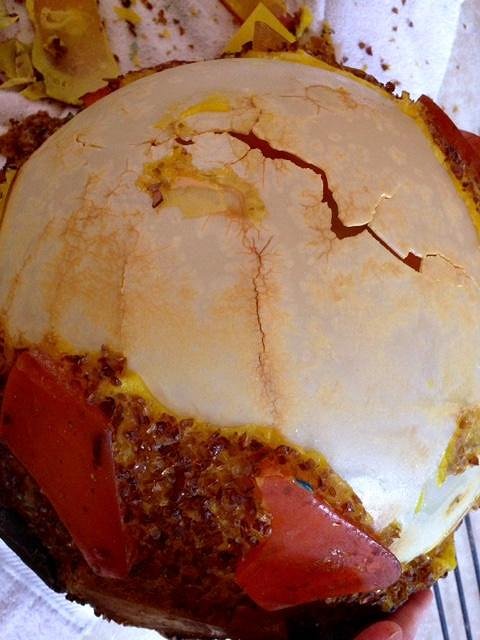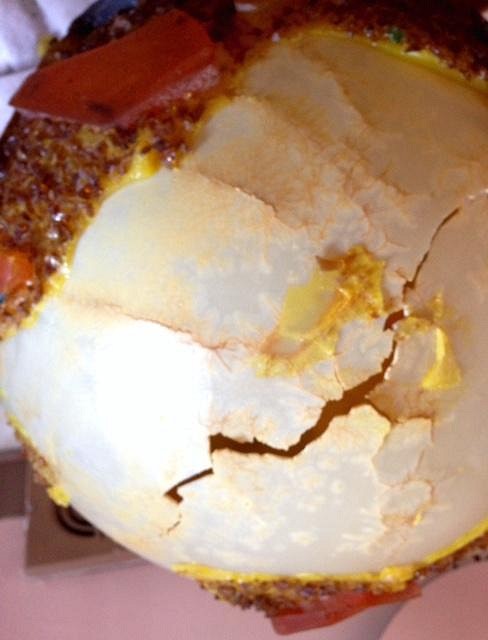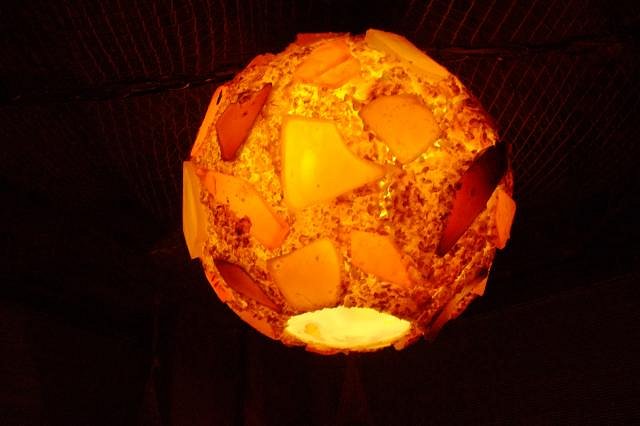Tiki Central / Other Crafts
Chunk light disaster - repair advice?
Pages: 1 19 replies
|
MAM

mike and marie
Posted
posted
on
Thu, Jul 16, 2015 6:44 PM
We had a disaster at space age central today. Found this great orange lucite chunk lamp -- just the shade -- and were excited to get it going. It was exactly the lamp we needed for the Malibu Room. These lamp shades are pretty delicate, but we did notice that the pieces seemed to flake off on this one more than any other we've seen, like the inside plastic globe itself was going brittle. So we very very carefully cleaned it with detergent and lukewarm water, set it down to dry. The next day Mike picked it up to bring it down to the workshop, and the inside globe part of it cracked and giant pieces of the lucite and chips started to fall off. It looks pretty bad, but really the majority of lucite is still on the globe itself -- these two shots are of the bad parts. However, the globe is definitely cracked in a few places. And it's obvious that the glue is all dried out -- if you wanted to, you could probably pry everything else off the globe with minimal effort. So, experts: what's the plan of attack? How can we salvage this besides using pieces parts in other projects -- should we even attempt to glue everything back and reinforce it all with something? Or should we take it all off and reglue on another globe? and what kind of glue?
|
|
ATP

Atomic Tiki Punk
Posted
posted
on
Thu, Jul 16, 2015 7:05 PM
You can glue it all together, but the structural integrity I myself wouldn't bother at this point, but all respect for those who don't quit! |
|
UT
uncle trav
Posted
posted
on
Fri, Jul 17, 2015 3:24 AM
WOW! That lamp is in rough shape. Like ATP said that plastic is literally deteriorating before your eyes. Most glues and adhesives used to repair plastics are solvent based and use a chemical reaction to melt the plastic back together and become rigid as they dry. This may do more harm than good. I'm no expert on the subject by any means. Would it be possible to support the globe shape from the inside and apply a very thin fiberglass cloth to the globe? Remove the support after the cloth has dried. A clear epoxy could then be used to hold the resin chunk pieces back in place. Like I said before I'm no expert. Just throwing ideas out. Good luck with your project and let us know how it goes. "Anyone who has ever seen them is thereafter haunted as if by a feverish dream" Karl Woermann [ Edited by: uncle trav 2015-07-17 03:28 ] |
|
T
tikiskip
Posted
posted
on
Fri, Jul 17, 2015 5:46 AM
If you can put the pieces back on like a puzzle use this glue... If you think it still needs reinforcement put resin on the outside of globe right over the pebble I have never done this but that is what I would try. Now if that's not a good idea for you then think about just using the good part, that is burry the Maybe even put in on the bottom of a basket and make a whole new basket type light. Or heck take the thing apart and make a new on, the hard part is finding those bigger chunk things. Good luck! |
|
MAM

mike and marie
Posted
posted
on
Tue, Jul 28, 2015 9:23 PM
Thanks everyone! Lots of great ideas & things to think about here ... and it seems like lights and lighting projects are foremost on our mind lately ... we will post updates with what we end up doing! |
|
MAM

mike and marie
Posted
posted
on
Sun, Mar 19, 2017 7:23 PM
Ok, 'bout time for an update... As you see from the date of the initial thread, this thing was sitting untouched in my workshop far too long. The big lucite chunks are cool, and so is the small glittery stuff, and yes they could be used for any number of projects, including new types of lights ... however, I had all the broken pieces of this thing, I love the shape and style of the original lamp, and ... I just can't give up! So last November I had the idea: finally get around to this, and fix it right, and give the lamp to Marie as a Christmas present. That meant I couldn't ask her for help but had to get this pieced together on the sly. I wasn't sure if I could, but I tried. First I got the E6000 glue that Tikiskip recommended. First thing I noticed was the tube was awfully small -- not much bigger than your average superglue. And looking over at this lamp, at least a third of it had fallen off. I was thinking, "Ok, this is not going to work." The other problem is, reading the labels I see that it's apparently one of those glues that give you like Stage 15 brain cancer if you accidentally inhale it for five seconds too long, and it's as flammable as space shuttle fuel so you have to keep it away from all pilot lights. It's November, I'm in the workshop not far from the furnace pilot, I'm thinking "Uh uh." So one day I take it all out into the garage and get moving. And basically it ends up a total mess: the glue doesn't stick, it stinks, I run out right away and the big chunks I test it on all fall right out with no tackiness at all. I'm ready to give up. I'm looking at this beautiful vintage lamp, and thinking "If only I had some tackiness here..." And then it hits me -- go with the tacky glue that I've used so much in the past. It held together a lot of the wood beams and rope in the Treasure Island Room's Wreck Bar, so maybe it would work here. I ran down and got some, tried it, and no -- it was just as bad as the E6000 stuff. So now I had a mess to clean, and those little flecks kept falling off and I had to keep them all carefully in a big brown paper bag, and I had to wait a day for the big pieces to dry before I could do anything. Looked back down in the workshop for another solution. There was Mod Podge, so useful for many tiki projects (and every home bar builder and tiki crafter should have a tub of it), but I tried it and although a bit tacky it wasn't strong enough. I'd get one to hold and then put another piece on and the first one fell off. This went on for about ten minutes before I gave that up. And then in desperation I turned to other glues I had. In particular, there was the tub of Titebond, wood glue that I use for furniture repairs and that's useful for working with rattan and bamboo. I didn't think it would work. But you know what -- after I let it sit for five minutes it tacked up perfectly, I was able to arrange a bunch of the big chunks, and then spray all the little shimmery pieces in the gluey sections in between. "This is it, it's all over," I thought, not even caring ... everyone was right, I figured that this was a lost cause ... then I came down the next morning and I couldn't believe it, the stuff had dried to the same exact color as the original lamp, and all the stuff held! When dry, this is just like the original epoxy or whatever it was they used to put it together. It's just a little translucent, like the chunk pieces themselves, so the light goes through it and glows ... so to finish this up, basically I had to do this for about 7 days, making 1-2 applications a day, gluing pieces on and putting the small flakey pieces in, and the cool thing is when this dripped, the dry pieces of it were nearly indistinguishable from some of the lucite pieces, so I could use them as well... Once I got all the outside stuff together I smeared a decent layer on the inside, and then put another layer on the outside, cutting off any drips from the big chunks with a razor blade. Then the next day I took it outside and gave it a coat of polyurethane. One more the day after. Then I took all my brand new lamp parts and a new LED light and put the baby together ... Boxed it all up just in time for Christmas... [ Edited by: mike and marie 2017-03-19 21:38 ] [ Edited by: mike and marie 2017-03-19 21:40 ] |
|
MAM

mike and marie
Posted
posted
on
Sun, Mar 19, 2017 7:24 PM
Hanging up in the Malibu Room now
|
|
C
croe67
Posted
posted
on
Sun, Mar 19, 2017 7:28 PM
WOW!! Incredible save - looks FAB!! |
|
M
MadDogMike
Posted
posted
on
Sun, Mar 19, 2017 11:49 PM
Looks great! In defense of E6000, I have used it for several projects and it has worked really well. WalMart and Lowe's have it in large tubes, clear and black. I have used it for several mosaic tables to glue ceramic and/or glass tiles to the glass table tops. But no glue works for every situation, guess it wasn't the right glue for this job. |
|
T
tikiskip
Posted
posted
on
Mon, Mar 20, 2017 4:39 AM
Glad to see you fixed it. “The other problem is, reading the labels” |
|
MAM

mike and marie
Posted
posted
on
Mon, Mar 20, 2017 6:18 PM
This was the E6000 I tried, a tiny tube from Menard's. It seemed like a good superglue type glue, but even if it would've worked for this I would've needed about 25 tubes. Most of the time you need something that dries clear. This was one of those times where the yellow wood glue was preferable. And just like it bonds furniture, it really fixed the brittle cracked globe. [ Edited by: mike and marie 2017-03-20 18:19 ] |
|
MAM

mike and marie
Posted
posted
on
Mon, Mar 20, 2017 6:20 PM
And sometimes ... I even follow what they say! :) |
|
M
MadDogMike
Posted
posted
on
Mon, Mar 20, 2017 9:58 PM
That's the wrong glue!!!! No wonder it didn't work LOL That is a fabric glue, the regular E6000 is like a thinner version of clear silicone caulking, but still a gel. Grips good and dries slightly flexible. Glad you found something that worked though, the end product looks great. |
|
T
tikiskip
Posted
posted
on
Tue, Mar 21, 2017 6:59 AM
"dries slightly flexible" That is another reason I would like E6000 over Titebond the glues that don't flex tend to crack over time or the thing you are gluing separates because of this rigidness. have you seen tiki lights that the trim is falling off of them? Yours should be fine as you caped it with resin I think you said. Yeah I think you got the wrong E6000. It's a big tube. |
|
MAM

mike and marie
Posted
posted
on
Tue, Mar 21, 2017 9:37 PM
I'll have to look out for the real E6000 then. You guys prefer it for most lamp projects? [ Edited by: mike and marie 2017-03-21 21:38 ] |
|
T
tikiskip
Posted
posted
on
Wed, Mar 22, 2017 6:18 PM
Well not really. Titebond does not dry clear this is it's draw back. Now for glass and plastic use E6000 as it will flex and holds well. For some plastic you may want to use Tester's model glue. Use Hot glue for felt, Ha! That's funny. Also tie down and even put pegs in to help things stay together. I do other things to make sure the glue stays stuck as well, like seal it. |
|
MAM

mike and marie
Posted
posted
on
Wed, Mar 22, 2017 8:39 PM
Good stuff. Thanks. Found a very well made rattan end table that someone was throwing away because some of the rattan was coming unwound on one of the legs. Some Titebond made it all better. |
|
M
MadDogMike
Posted
posted
on
Thu, Mar 23, 2017 7:31 AM
This was an E6000 project - silver dollar sized ceramic glued to the center of trailer hubcaps, both non-porous. Lasted several thousand miles at 60 MPH :D |
|
T
tikiskip
Posted
posted
on
Fri, Mar 24, 2017 8:55 PM
Yeah, that's a good use for it. |
|
MAM

mike and marie
Posted
posted
on
Sat, Mar 25, 2017 10:31 PM
Cool hubcap! |
Pages: 1 19 replies




